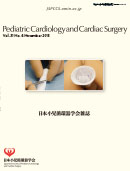Volume 31, Issue 6
Displaying 1-16 of 16 articles from this issue
- |<
- <
- 1
- >
- >|
Editorial
-
2015Volume 31Issue 6 Pages 289-291
Published: November 30, 2015
Released on J-STAGE: December 23, 2015
Download PDF (5439K)
Reviews
-
2015Volume 31Issue 6 Pages 292-298
Published: November 30, 2015
Released on J-STAGE: December 23, 2015
Download PDF (491K) -
2015Volume 31Issue 6 Pages 301-308
Published: November 30, 2015
Released on J-STAGE: December 23, 2015
Download PDF (2060K)
Originals
-
2015Volume 31Issue 6 Pages 309-312
Published: November 30, 2015
Released on J-STAGE: December 23, 2015
Download PDF (187K) -
2015Volume 31Issue 6 Pages 313-319
Published: November 30, 2015
Released on J-STAGE: December 23, 2015
Download PDF (13689K) -
2015Volume 31Issue 6 Pages 322-328
Published: November 01, 2015
Released on J-STAGE: December 23, 2015
Download PDF (259K) -
2015Volume 31Issue 6 Pages 329-337
Published: November 30, 2015
Released on J-STAGE: December 23, 2015
Download PDF (8131K) -
2015Volume 31Issue 6 Pages 340-344
Published: November 30, 2015
Released on J-STAGE: December 23, 2015
Download PDF (3854K)
Case Reports
-
2015Volume 31Issue 6 Pages 347-351
Published: November 30, 2015
Released on J-STAGE: December 23, 2015
Download PDF (5980K) -
2015Volume 31Issue 6 Pages 352-357
Published: November 30, 2015
Released on J-STAGE: December 23, 2015
Download PDF (4612K)
Editorial Comments
-
2015Volume 31Issue 6 Pages 299-300
Published: November 30, 2015
Released on J-STAGE: December 23, 2015
Download PDF (134K) -
2015Volume 31Issue 6 Pages 320-321
Published: November 30, 2015
Released on J-STAGE: December 23, 2015
Download PDF (99K) -
2015Volume 31Issue 6 Pages 338-339
Published: November 30, 2015
Released on J-STAGE: December 23, 2015
Download PDF (3281K) -
2015Volume 31Issue 6 Pages 345-346
Published: November 30, 2015
Released on J-STAGE: December 23, 2015
Download PDF (150K) -
2015Volume 31Issue 6 Pages 358-359
Published: November 30, 2015
Released on J-STAGE: December 23, 2015
Download PDF (110K)
-
2015Volume 31Issue 6 Pages 360-361
Published: November 30, 2015
Released on J-STAGE: December 23, 2015
Download PDF (5283K)
- |<
- <
- 1
- >
- >|
